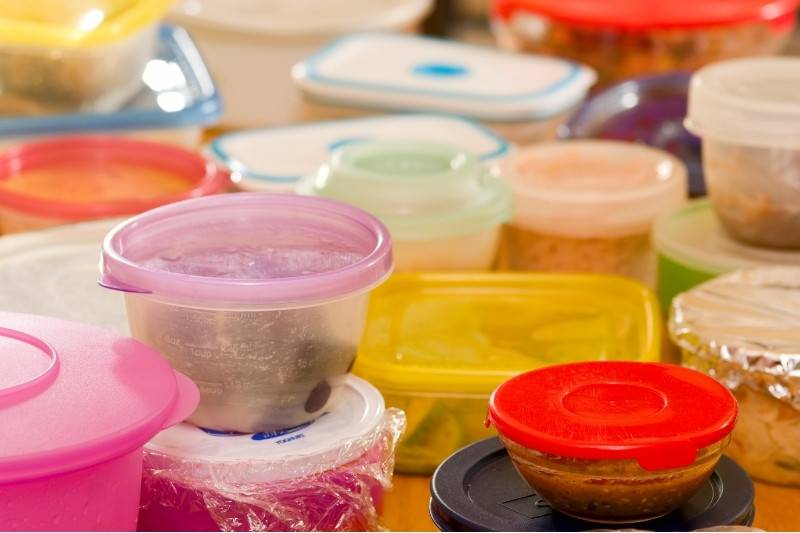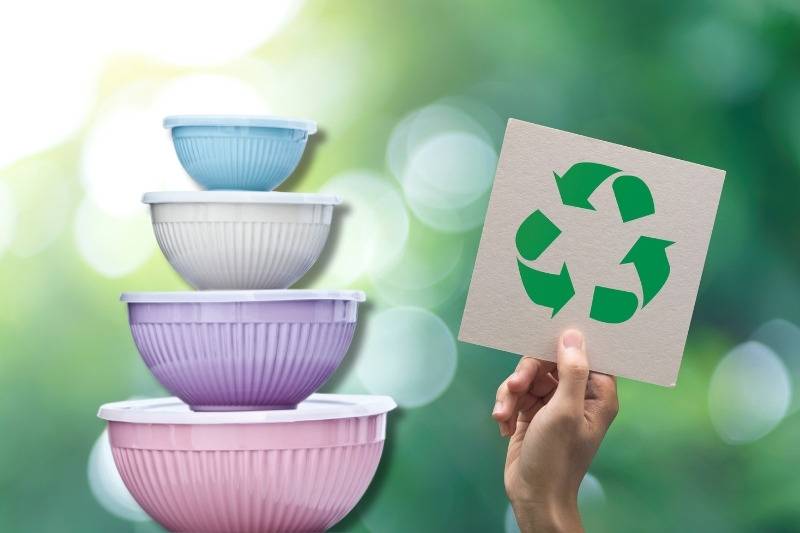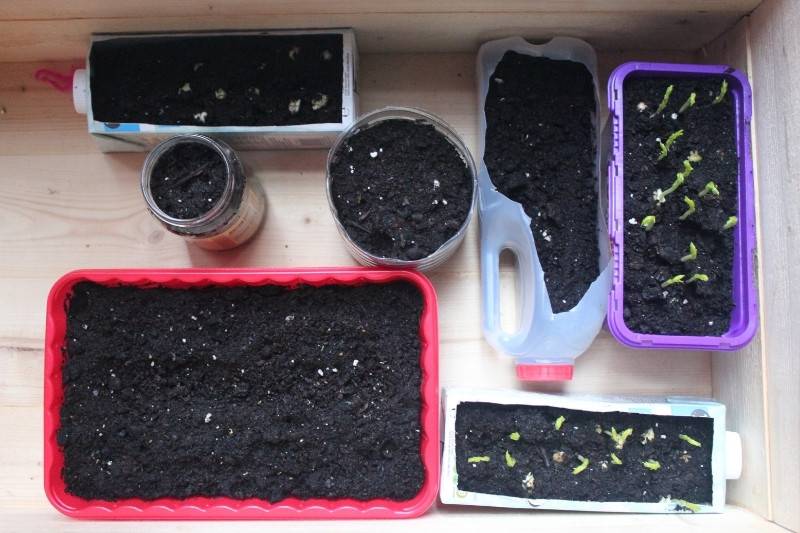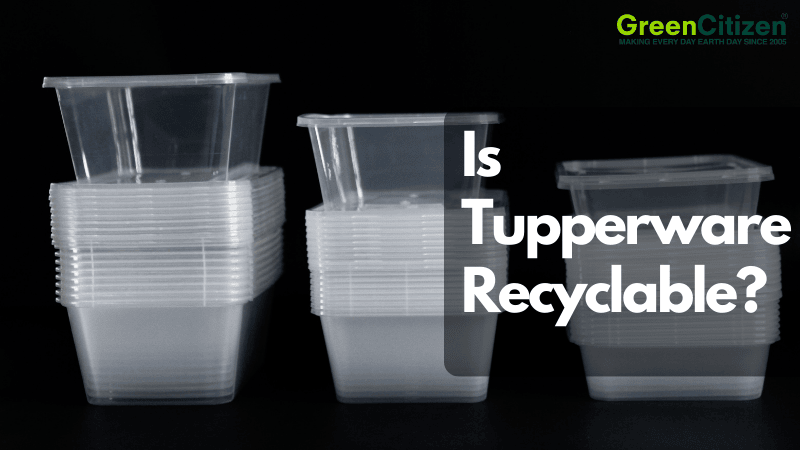Hey there, friends! I know many of you, just like me, have been on the hunt to make our daily habits a tad greener.
We all have those trusty Tupperware containers stashed somewhere in our kitchens, right?
They’ve saved the day countless times, holding leftovers or packing lunches. But here’s a question that’s been on my mind: is Tupperware recyclable?
Recycling plays a key role in our fight against waste, and it’s high time we dug deep into how our beloved Tupperware fits into this picture.
Stick around as I unravel this mystery for us.
What is Tupperware Made Of?
Before diving into whether we can toss Tupperware into our recycling bins, it’s crucial to understand what these nifty plastic food storage containers are made of.
Tupperware: More Than Just a Container
Tupperware is actually a brand name, much like how we often say “Kleenex” for tissue or “Band-Aid” for adhesive bandages.
Founded in 1946 by Earl Tupper, Tupperware revolutionized the way we store food. While today we might just see them as regular plastic storage containers again, they were groundbreaking at the time, introducing the idea of airtight and watertight seals. This “burping seal” was a game-changer, ensuring food stayed fresher for longer.
Made primarily from plastic, Tupperware containers were promoted not just as storage solutions but as a way of life. They represented a shift in post-war America towards modernity and convenience.
And you know what’s fascinating?
Tupperware parties!
These were social events where a Tupperware salesperson would demonstrate the benefits of these reusable containers to a group, usually women. It was a blend of socializing, shopping, and, well, sealing old plastic containers together!
But beyond its history, the name “Tupperware” has become synonymous with quality. Even today, if someone says, “Put it in the Tupperware,” they’re not just talking about any container. They’re referring to a reliable, durable, and, let’s admit, a somewhat nostalgic piece of kitchenware.
So, when we’re exploring whether Tupperware is recyclable or understanding what it’s made of, we’re not just digging into plastic. We’re unraveling a bit of history, understanding a brand that’s been a silent witness to countless family meals, leftovers, and lunch breaks.
Quite the journey, right?
Composition of Tupperware Products

At its core, Tupperware is made of plastic.
But wait!
It’s not just any regular plastic.
Over the years, I’ve discovered that Tupperware primarily uses high-quality, food-safe plastics. These are crafted to last long and withstand everyday wear and tear, which is why that old container from Aunt Sue is still going strong in our kitchen!
But, of course, like many things in life, not all Tupperware plastic containers and plastics are the same.
Certainly! Let’s integrate this information into the previous section to provide clarity:
Can You Recycle Tupperware?
Yes, you can recycle Tupperware.
However, its recyclability depends on the type of plastic it’s made from and the recycling capabilities of your local facilities.
It’s essential to check the Resin Identification Code (a number inside the recycling bin or triangle) on the bottom of your Tupperware product and consult your local recycling guidelines to determine if that particular type of plastic is accepted.
Recycling Symbols at the Bottom of Plastic Containers

Ever turned your empty Tupperware container (or any plastic container) upside down to notice a number within a triangle? That’s the Resin Identification Code, and it’s vital for recycling.
Here’s a brief table to decode these symbols and their general recyclability:
| Recycling Number | Plastic Type | Commonly Found In | Recyclable? |
|---|---|---|---|
| 1 | PET | Soft drink bottles, textile fibers | Yes |
| 2 | HDPE | Milk jugs, detergent bottles | Yes |
| 3 | PVC | Pipes, toys, credit cards | Rarely (due to chemicals) |
| 4 | LDPE | Grocery bags, cling films | Yes, but not everywhere |
| 5 | PP | Yogurt pots, straws, Tupperware | Increasingly accepted |
| 6 | PS | Coffee cups, disposable plates | Rarely (due to styrene) |
| 7 | Other | Various, including polycarbonate | Varies |
While the above indicates general recyclability, it’s essential to check local guidelines, as local recycling programs and facility capabilities differ by region.
Challenges in Tupperware Recycling
Tupperware emphasizes the longevity of their products, encouraging users to maximize their lifespan. When it’s time to recycle, many Tupperware items, especially those made of PP (number 5), can be recycled.
However, this depends on local recycling capabilities.
It’s always recommended to refer to Tupperware’s guidelines and your community’s recycling programs and policies.
Recycling Tupperware poses challenges, such as:
- Mixed Materials: Items combining different plastics can complicate recycling.
- Food Residue: Leftovers or detergents might contaminate the recycling stream.
- Aging and Wear: Over time, some Tupperware items might not be recyclable due to wear or structural changes.
While recycling Tupperware is an excellent step, reusing these durable containers is also a significant move towards sustainability.
Every reused container reduces waste!

Read More:
Is Old Tupperware Safe for Using?
Nostalgia often hits when we pull out our vintage Tupperware containers — reminiscent of family potlucks and grandmother’s leftovers.
But in the midst of these memories, it’s crucial to ask: Is this old Tupperware safe to use?
Vintage Tupperware and Harmful Chemicals
Back in the day, the manufacturing process of many plastics, including some Tupperware, was different than it is today.
Vintage Tupperware products, often the ones from the 1970s and 1980s, may contain harmful chemicals that could potentially leach into food, especially when the containers are heated or are showing signs of wear.
While these containers were considered safe according to the standards of their time, research has since illuminated concerns about certain chemicals used in plastics.
Here’s a breakdown:
Bisphenol A (BPA)
One of the main culprits in these discussions is Bisphenol A, commonly known as BPA. BPA is a chemical that was widely used in plastics to enhance flexibility and strength.
Over time, studies have suggested that BPA can migrate from plastic containers into food and beverages, especially under conditions of high heat or damage.
Prolonged exposure to BPA has been linked to potential health concerns, including hormonal imbalances and potential risks to the brain and behavior in fetuses, infants, and young children.
As a result, many manufacturers, including Tupperware, have switched to BPA-free products in recent years. However, the concern remains for those vintage plastic food containers still sitting at the back of our cupboards.
Polychlorinated Biphenyls (PCBs)
Some old Tupperware products have been found to release PCBs, especially when used for storing fatty foods like meat or cheese.
While PCBs were more commonly associated with electrical equipment, their presence in some older plastic items has been a point of concern.
PCBs are known to be harmful and can cause a range of health issues, including cancer, immune system disruption, and neurological problems.
Lead and Cadmium
Certain colorful vintage Tupperware pieces, particularly those from the 1960s and 1970s, were decorated with paint that contained lead and cadmium.
While these heavy metals wouldn’t necessarily leach into food like BPA might, they can become a problem if the paint chips off or if the container degrades over time.
Both lead and cadmium are toxic, with lead causing neurological problems and developmental delays, and cadmium affecting the kidneys and bones.
Phthalates
Like BPA, phthalates are another group of chemicals used to enhance the flexibility of plastics.
There are concerns about phthalates because they can disrupt hormones and may be linked to several health issues like birth defects, fertility problems, and cancer.
It’s worth noting that not all Tupperware products would have contained phthalates, but they were prevalent in many other plastic containers and items in the past.
If you possess vintage Tupperware and are concerned about its safety, a sensible first step might be to stop using it for food storage, particularly with fatty or acidic foods, and avoid microwaving or heating in them. To determine if your items contain any of these toxic chemicals, specialized testing would be necessary.
Given the uncertainties, many people choose to recycle or retire their old Tupperware and replace it with newer, confirmed-safe alternatives.
Signs That Your Old Tupperware Needs Replacement

Tupperware has been a kitchen mainstay for decades, from hosting leftovers to being the trusted container for on-the-go lunches.
However, like all things, Tupperware doesn’t last forever.
So how do you know when it’s time to bid adieu to your beloved containers and lids?
Here are some signs to look out for:
It has Stains and Smells Funny
Over time, Tupperware can absorb the colors and odors of the food they store, particularly if they held items like tomato sauce, curries, or foods with potent spices.
While occasional staining might be cosmetic, persistent odors indicate the plastic’s porous nature is absorbing residue.
This not only poses potential health concerns, as bacteria can thrive in these environments, but it can also alter the flavor of new foods stored inside.
It’s Warped
Have you ever taken your Tupperware out of the dishwasher and found it’s taken on a new, unintended shape?
Warping can happen due to exposure to high temperatures or storing very hot foods.
A warped container isn’t just an aesthetic issue; it can compromise the seal, making it less effective for storing food safely.
Where Are the Lids?
A Tupperware without its corresponding lid is like a shoe without its match—practically pointless.
If the lids are cracked, they can harbor bacteria in the crevices. Similarly, deformed lids can’t seal containers properly, making food prone to contamination or spoilage.
Age Matters: Pre-2010 Containers
While age alone doesn’t determine a container’s safety, Tupperware made before 2010 might not meet the more stringent safety standards of today. For instance, some older containers might contain BPA or other now-avoided chemicals.
This is especially true if your container is from the brand Tupperware. They officially introduced BPA-Free containers after 2010.

Read More:
How To Recycle Tupperware Responsibly
Given our ever-growing commitment to the environment, it’s not just enough to use products for their lifetime, but it’s equally vital to ensure their proper disposal.
Before discarding your old Tupperware in the recycling bin, it’s a good idea to contact your local recycling center.
Different facilities have varied capabilities and regulations.
By giving them a quick call or checking their website, you can verify if they accept the specific type of plastic your Tupperware is made of.

If you’re unsure where your nearest recycling center is, the Green Directory from GreenCitizen can be an invaluable tool. This online resource provides a comprehensive list of recycling centers, allowing users to search by material (like plastics) and location.
Simply visit Green Directory, input the relevant details, and get information on recyclers near you.
Prepping Your Tupperware for Recycling
Before handing over your containers:
- Clean It Up: Ensure that your Tupperware is free from food residue. Give it a good wash and let it dry.
- Separate Components: If your container has multiple components, like a rubber seal or a different plastic lid, try to separate these parts. Mixed materials can complicate the recycling process.
- Check for Recycling Symbols: Remember the resin identification codes we discussed earlier? Make sure you're aware of your Tupperware's code, as this will guide the recycling process.
In the grand scheme, while Tupperware is just a small piece of our vast consumer world, every responsible decision counts. Proper disposal isn’t just about decluttering—it’s about respecting our planet and paving the way for a greener future.
How To Give Old Tupperware A New Life
Even if your trusty Tupperware is past its prime for food storage, it doesn’t mean it’s done serving you. Upcycling, distinct from most recycling programs, allows you to repurpose objects, giving them new life in innovative ways. Let’s delve into how you can reimagine the uses of these containers.
Reusing Tupperware
Every container has a story, and every story can have sequels. Here’s how you can continue the narrative of your Tupperware:
- Stationery Organizer: Those old containers can become your desktop companion, holding pens, pencils, and markers.
- Jewelry Storage: Small Tupperware units can become treasure chests for your earrings, necklaces, and other trinkets, preventing them from getting lost.
- Seed Starter: Initiate your gardening journey by using containers as mini greenhouses for seedlings.
- Craft Supplies Holder: Whether it's beads, buttons, or sequins, your Tupperware can help organize it all.
Upcycling Ideas

Stretch your creative muscles and transform your old Tupperware container into something unique. While I can’t provide images, I’ll detail the process, making it easy for you to visualize and implement:
- Tupperware Planter: Drill a few holes at the bottom, fill it with soil, and you have a quirky planter ready. Decorate the exterior with paint or decals for added flair.
- Homemade Candle Mold: Use your Tupperware to mold DIY candles. Ensure you use a release agent for easier extraction.
- DIY Bird Feeder: Attach a string to the lid, flip the container, fill it with bird seeds, and hang it outdoors.
- Mini Sewing Kit: Old, tiny Tupperware containers can be ideal for storing needles, threads, and other sewing essentials.
- Drawer Dividers: Cut larger containers to size and use them as dividers to organize drawers.
Remember, every bit of effort counts in the greater journey towards sustainability. Your Tupperware might retire from one job but, with imagination, can take up many other roles in its lifetime.
What Are The Best Plastic Container Alternatives?
When considering the environment and health, many are seeking alternatives to the traditional plastic containers that have long been staples in our kitchens.
We’ve grown up using these, but as our understanding of sustainability grows, so does the need for healthier and more eco-friendly options.
Here’s a look at some of the top alternatives to plastic containers:
Bamboo Containers
Why They Shine:
- Sustainability: Bamboo is a fast-growing, renewable resource. Unlike many woods, bamboo can be harvested without killing the plant, allowing it to regrow quickly.
- Biodegradable: At the end of its life cycle, bamboo will naturally decompose, returning to the earth without leaving any harmful residues.
- Durability: Bamboo has a natural strength, making containers made from it both sturdy and lightweight.
- Aesthetically Pleasing: Bamboo containers often have a warm, earthy look that adds a touch of elegance to kitchen decor.
Stainless Steel Containers
Why They Shine:
- Durability: Stainless steel is known for its strength and longevity. These containers can withstand a lot of wear and tear.
- Non-reactive: Unlike some plastics, stainless steel won’t leach chemicals into your food, even when storing acidic or hot items.
- Easy Maintenance: Stainless steel containers are usually dishwasher safe, and they don’t stain or retain odors like some plastics can.
- Temperature Resistance: They can handle hot or cold temperatures, making them versatile for different storage needs.
Glass Containers
Why They Shine:
- Chemical-Free Storage: Glass is non-porous and doesn’t absorb colors or odors, ensuring that your food remains untainted by any foreign substances.
- Microwave Safe: Most glass containers can go from the freezer to the microwave without any issue, which isn’t the case with many plastics.
- Transparency: A clear advantage, literally! You can easily see the contents, helping in better organization and monitoring of stored foods.
- Eco-Friendly: Glass is 100% recyclable, meaning it can be recycled endlessly without any degradation in quality.
Frequently Asked Questions (FAQ)
Tupperware is often made of mixed plastic materials, which many recycling plants find challenging to process. Additionally, food residues can contaminate the recycling process.
You can upcycle it into storage for non-food items, use it as a planter, make it into a bird feeder, or consider donating it if it’s still in usable condition.
Vintage Tupperware made before the 1980s may contain harmful chemicals like BPA. It’s best to use them for non-food purposes or replace them.
Tupperware uses a variety of plastics, but many of their products are made from #5 plastic, also known as polypropylene.
Tupperware promotes reusable storage solutions, reducing the need for single-use plastics. Additionally, some product lines are made with sustainable materials or through energy-efficient processes.
No, the majority of Tupperware products are made of plastic. However, they do offer some products made from other materials, and they’re continuously innovating for sustainability.
Conclusion
In an age where sustainability is more than just a buzzword, understanding the footprint of everyday items like Tupperware becomes crucial.
While these containers have made life convenient by providing efficient storage solutions, it’s equally essential to recognize their impact on our planet.
Their challenges in recycling, the potential health concerns with older versions, and the steps we can take for responsible usage and disposal all play a part in our broader environmental journey.
However, there’s hope on the horizon. With options to upcycle, responsibly dispose of, or even transition to eco-friendlier alternatives, we have the power to make informed choices.
Remember, every sustainable step counts, whether it’s repurposing an old container or investing in a bamboo or glass alternative. Let’s strive for a world where convenience and care for our planet coexist harmoniously.

